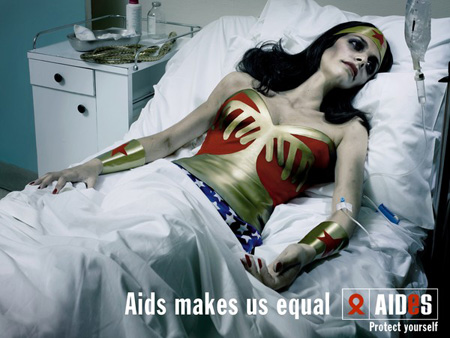Does fear-based marketing work?

Fear-based marketing exists for one simple reason: we know emotions affect buying behavior. Each one of us can recall cases when we bought something just because we felt bad (or good, or lost, or inspired). And then, perhaps, never even used the product. Home trainers, anyone? Unread books? Clothes that seem not that cool right after they are in the closet?
We know that loads of our buying choices are emotional rather than rational. However, when it comes to specific emotions, such as sexual arousal or fear… Things get much more complicated. Sure, sometimes these messages work. For anyone who doesn’t believe in the power of a fear-based message, conventional marketers suggest going into a building and screaming "fire". However, for marketers, knowing that something works in some cases is not enough. We have to know when, how, and with what products you can scare the customer into going for it. Surely you can’t just run into a room full of people and, holding meds in your hand, scream “BACK PAIN!!!”
It’s also necessary to point out that using fear in advertising is very common, especially when it comes to social advertising. These messages are strong, moving, and obviously well-made.



Others, not that well-made.
But do they work? Well, it's not that easy to find out.
So let's turn to research.
Self-identification
Most research around fear appeals is related to discouraging various behaviors such as smoking, drug use, drinking and driving, unsafe sex, etc. In the early 90s, a number of marketing campaigns aimed to discourage unsafe sex through the fear of getting AIDS were developed in the UK. The campaigns were proven ineffective. Teenagers would recognize the dangers presented but refuse to identify with them.
Can you feel the marketing takeaway?
Your buyer should identify with the danger. They should feel it can truly happen to them. And not just because “hey, it can happen to anyone” or “it happens to 25% of the population and you can be in this 25%”. People are not impressed by statistics. They don’t understand statistics, really.
People prefer stories. Tell a story of someone like your buyer persona getting into a situation that they’ve been in, reacting to it in a way they’d react, and taking the action (solving the scary problem!) with your product. Of course, you've got to understand your target audience really well for that.
The boomerang effect
In 2006, the effect of several anti-smoking fear-based campaigns was studied among college students. Turned out the campaigns weren’t effective. Quite the opposite, the participants reported wanting a cigarette after viewing the ad! Instead of fear, they experienced anger and defiance.
Similarly, early research found that an anti-drug campaign decreased negative attitudes towards dangerous drugs and people were more attracted to TV shows that had warnings of violence in them. In a comprehensive study of colleges that ran social marketing campaigns to reduce heavy drinking, there was no significant decrease in drinking. Again, quite the opposite: a pattern of increased drinking emerged.
Why does this happen?
Truth is, we can’t be sure. Many theories exist, most around the idea that when we’re faced with the necessity to change behavior that we don’t want to change, we change the attitude to the behavior. Smoking, for example, becomes not just something nice but life-threatening (that feels like an unfair deal). It becomes a matter of personal freedom; a behavior integral to one's personality. Protecting the right to smoke becomes self-protection. So in the best case scenario, the person does nothing, and in the worst case scenario, they affirm the behavior by sticking to the habit even more.
This is why it’s not uncommon to see anti-smoking ads made by tobacco brands. The ads have better chances of being beneficial rather than harmful to the companies.
Helplessness
Where would we be without meta-analyses that show us the pattern among the dozens of studies? Thankfully, a meta-analysis of fear appeals was done and revealed an interesting pattern. Despite multiple negative studies, fear appeals might have a relatively weak but reliable effect on attitudes, intentions, and behaviors. But only fear appeals accompanied by high-efficacy messages.
Hard-to-grasp marketing takeaway:
In most cases, people don’t really believe they are able to effectively avert a threat and, therefore, choose to ignore the fear message. Hence, fear-based marketing campaigns should also aim to raise self-efficacy. Presenting a product that would simply “solve all the problems” is not enough. Self-perception of helplessness is bigger than that. The marketing message should remove all barriers between the person and their reasons for inactivity. It should directly address the required skills, costs, beliefs, emotions, etc.
Easy-to-grasp marketing takeaway:
After you’ve scared people into doing something, put all your effort into empowering them. Convince them they can do it.
Having said that…
Fear-based marketing seems complicated and uneven in its performance. What if we just leave the encouraging part and see how that works?
MarketingExperiments tested that out:
First, they looked at which tactic would increase retention for a company dealing with protecting online security.
The consequences of not taking care of online security can be quite dangerous. So fear appeal is totally justified. The two tactics they tested were:
1. Informing people about how to increase online security, focusing on education and empowerment.
2. Threatening people with ads such as "A computer is a weapon".
The first approach won by 3%, which is a lot when translated to paying customers.
Then, marketers looked at which life-insurance ad will win. Again, this is a topic where fear-based marketing is often used, and it seems logical. The two proposed messages were these:
1. “Don’t wait to protect your family’s future” (fear appeal: you might be too late to protect your family!)
2. “Protect Your Family with affordable life insurance” (no fear appeal, empowerment used instead)
Can you guess the result?
The second version increased downloads by 91%.
Finally, you often see fear and guilt appeals in non-profit organizations. Again, marketers tested if they really work. The two versions were:
1. “Make sure Deborah is not alone this holiday season”
2. "CaringBridge needs your help”
Using the second version led to a 31% decrease in donations.
I am guessing you can see the point by now. Making people feel afraid, guilty, or sad won't take you far. Most will switch off the TV or quickly scroll down the page not to be exposed to these feelings in the first place. Some will quickly justify their inaction: life insurance can be bought some other time, Subaru Forester is too expensive, quitting smoking is too hard, AIDS is not even that widespread anymore. It doesn't matter whether the fear base in your marketing message is justified or not, or whether people believe you or not. Fear is just not motivational.
The reason why fear appeals are used despite that is that they stand out. Positive advertising is everywhere and it's just not highly noticeable anymore, while negativity still is. Well, get creative. Or choose other marketing methods to convince people to buy your product. But stay on the light side.













